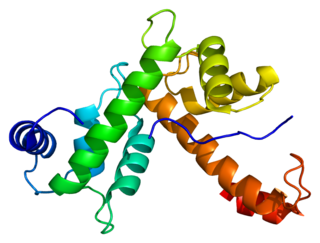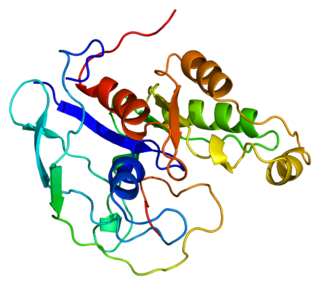
The G protein-coupled bile acid receptor 1 (GPBAR1) also known G-protein coupled receptor 19 (GPCR19), membrane-type receptor for bile acids (M-BAR) or TGR5 as is a protein that in humans is encoded by the GPBAR1 gene.

Cbl is a mammalian gene encoding the protein CBL which is an E3 ubiquitin-protein ligase involved in cell signalling and protein ubiquitination. Mutations to this gene have been implicated in a number of human cancers, particularly acute myeloid leukaemia.

Calmodulin 1 is a protein that in humans is encoded by the CALM1 gene.

Nucleoside diphosphate kinase A is an enzyme that in humans is encoded by the NME1 gene. It is thought to be a metastasis suppressor.

Programmed cell death protein 6 is a protein that in humans is encoded by the PDCD6 gene.

The alpha-1B adrenergic receptor (α1B-adrenoreceptor), also known as ADRA1B, is an alpha-1 adrenergic receptor, and also denotes the human gene encoding it. The crystal structure of the α1B-adrenergic receptor has been determined in complex with the inverse agonist (+)-cyclazosin.

Serine/threonine-protein kinase D1 is an enzyme that in humans is encoded by the PRKD1 gene.

Activated CDC42 kinase 1, also known as ACK1, is an enzyme that in humans is encoded by the TNK2 gene. TNK2 gene encodes a non-receptor tyrosine kinase, ACK1, that binds to multiple receptor tyrosine kinases e.g. EGFR, MERTK, AXL, HER2 and insulin receptor (IR). ACK1 also interacts with Cdc42Hs in its GTP-bound form and inhibits both the intrinsic and GTPase-activating protein (GAP)-stimulated GTPase activity of Cdc42Hs. This binding is mediated by a unique sequence of 47 amino acids C-terminal to an SH3 domain. The protein may be involved in a regulatory mechanism that sustains the GTP-bound active form of Cdc42Hs and which is directly linked to a tyrosine phosphorylation signal transduction pathway. Several alternatively spliced transcript variants have been identified from this gene, but the full-length nature of only two transcript variants has been determined.

Beta-2-syntrophin is a protein that in humans is encoded by the SNTB2 gene.

Sterile alpha motif and leucine zipper containing kinase AZK, also known as ZAK, is a human gene.

Tyrosine-protein kinase receptor TYRO3 is an enzyme that in humans is encoded by the TYRO3 gene.

Serine/threonine-protein kinase Nek6 is an enzyme that in humans is encoded by the NEK6 gene.

Serine/threonine-protein kinase D2 or PKD2 is an enzyme that in humans is encoded by the PRKD2 gene.

Disks large-associated protein 1 (DAP-1), also known as guanylate kinase-associated protein (GKAP), is a protein that in humans is encoded by the DLGAP1 gene. DAP-1 is known to be highly enriched in synaptosomal preparations of the brain, and present in the post-synaptic density.

Triadin, also known as TRDN, is a human gene associated with the release of calcium ions from the sarcoplasmic reticulum triggering muscular contraction through calcium-induced calcium release. Triadin is a multiprotein family, arising from different processing of the TRDN gene on chromosome 6. It is a transmembrane protein on the sarcoplasmic reticulum due to a well defined hydrophobic section and it forms a quaternary complex with the cardiac ryanodine receptor (RYR2), calsequestrin (CASQ2) and junctin proteins. The luminal (inner compartment of the sarcoplasmic reticulum) section of Triadin has areas of highly charged amino acid residues that act as luminal Ca2+ receptors. Triadin is also able to sense luminal Ca2+ concentrations by mediating interactions between RYR2 and CASQ2. Triadin has several different forms; Trisk 95 and Trisk 51, which are expressed in skeletal muscle, and Trisk 32 (CT1), which is mainly expressed in cardiac muscle.

Tyrosine-protein kinase BLK, also known as B lymphocyte kinase, is a non-receptor tyrosine kinase that in humans is encoded by the BLK gene. It is of the Src family of tyrosine kinases.

Membrane-associated guanylate kinase, WW and PDZ domain-containing protein 2 also known as membrane-associated guanylate kinase inverted 2 (MAGI-2) and atrophin-1-interacting protein 1 (AIP-1) is an enzyme that in humans is encoded by the MAGI2 gene.

Ras GTPase-activating protein 3 is an enzyme that in humans is encoded by the RASA3 gene.

Muskelin is a protein that in humans is encoded by the MKLN1 gene.

Liprin-alpha-4 is a protein that in humans is encoded by the PPFIA4 gene.

























